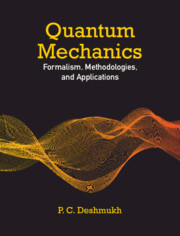Book contents
- Frontmatter
- Dedication
- Contents
- List of Figures
- Foreword
- Preface
- 1 Description of a Physical System
- 2 Path Integral Formulation of Quantum Mechanics
- 3 Probability Tangles and Eigenstates of One-dimensional Potentials
- 4 Angular Momentum
- 5 The Non-relativistic Hydrogen Atom
- 6 Approximation Methods
- 7 The Relativistic Hydrogen Atom
- 8 Quantum Mechanics of Spectral Transitions
- 9 The Many-Electron Atom
- 10 Quantum Collisions
- 11 Introduction to Quantum Information and Quantum Computing
- Appendix A Symmetry of the Hamiltonian
- Appendix B Schrödinger, Heisenberg, and Dirac “Pictures” of Quantum Dynamics
- Appendix C Spherical Harmonics
- Appendix D Occupation Number Formalism Second Quantization
- Appendix E Electron Structure Studies with Qubits
- Index
3 - Probability Tangles and Eigenstates of One-dimensional Potentials
Published online by Cambridge University Press: 14 September 2023
- Frontmatter
- Dedication
- Contents
- List of Figures
- Foreword
- Preface
- 1 Description of a Physical System
- 2 Path Integral Formulation of Quantum Mechanics
- 3 Probability Tangles and Eigenstates of One-dimensional Potentials
- 4 Angular Momentum
- 5 The Non-relativistic Hydrogen Atom
- 6 Approximation Methods
- 7 The Relativistic Hydrogen Atom
- 8 Quantum Mechanics of Spectral Transitions
- 9 The Many-Electron Atom
- 10 Quantum Collisions
- 11 Introduction to Quantum Information and Quantum Computing
- Appendix A Symmetry of the Hamiltonian
- Appendix B Schrödinger, Heisenberg, and Dirac “Pictures” of Quantum Dynamics
- Appendix C Spherical Harmonics
- Appendix D Occupation Number Formalism Second Quantization
- Appendix E Electron Structure Studies with Qubits
- Index
Summary
The belief that there is only one truth, and that oneself is in possession of it, is the root of all evil in the world.
—Max BornIn this chapter, we build on the principles of quantum mechanics introduced in the previous two chapters to apply the same to physical situations. First, we shall address simple one-dimensional physical problems. These would involve single particles interacting with a potential.
3.1 Probability Current Density
We have learned in Chapter 1 that if represents an energy eigenstate, then it is stationary and its time dependence is described by (Eqs. 1.114a,b and Eq. 1.115). The contribution of this term to the integrand in Eq. 1.109 and in Eq. 1.111a,b is essentially unity, no matter what the value of time t is. In this case, the probability density becomes independent of time. However, in other cases, the probability density, and hence the probability of finding a particle represented by the state vector within a volume element about the position, is time dependent. It then becomes necessary to determine
The partial derivative with respect to time of the product of the wavefunction and its complex conjugate requires, which is available from the time-dependent Schrödinger equation. Also required is, which is readily obtainable from its complex conjugation.
The result of the Solved Problem P3.1 at the end of this chapter, viz.,
has exactly the same form as the equation of continuity in fluid dynamics and also in electrodynamics (Eq. 10.26 and Eq. 13.71c in Reference [1]). In the above equation,
or writing the same compactly, with the arguments implicit,
In terms of the momentum operator,
and it is called as the probability current density vector. Its integral over the whole space gives us
where is the expectation value of the momentum operator at the instant t. The dimensions of the probability current density vector are L-2T-1. Notwithstanding the above relations, the probability current density vector at a point is not directly measurable. It would not be appropriate to equate it to the average particle flux at a point at a specific instant of time, though such an interpretation can sometimes be useful.
Information
- Type
- Chapter
- Information
- Quantum MechanicsFormalism, Methodologies, and Applications, pp. 98 - 146Publisher: Cambridge University PressPrint publication year: 2024
